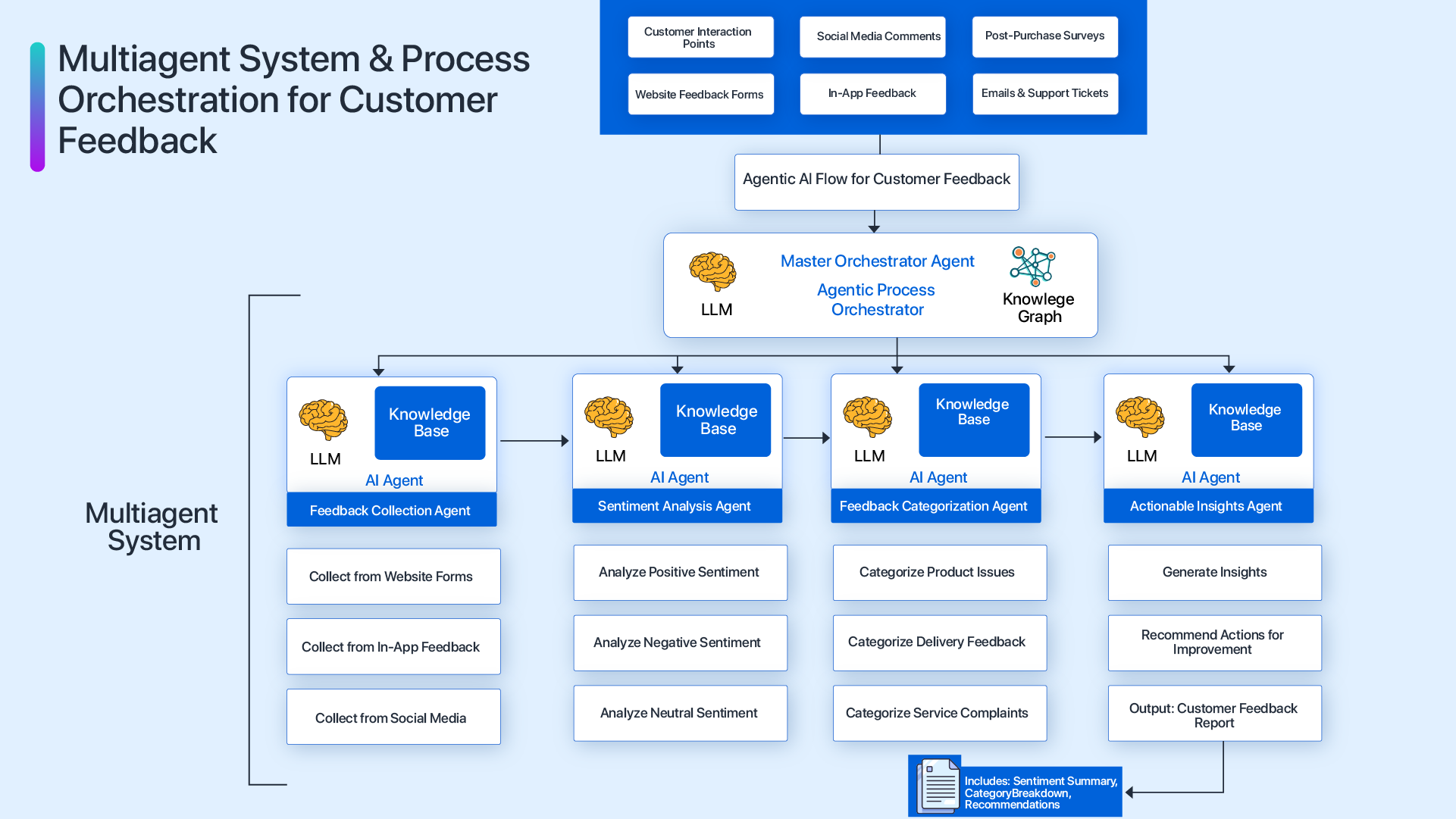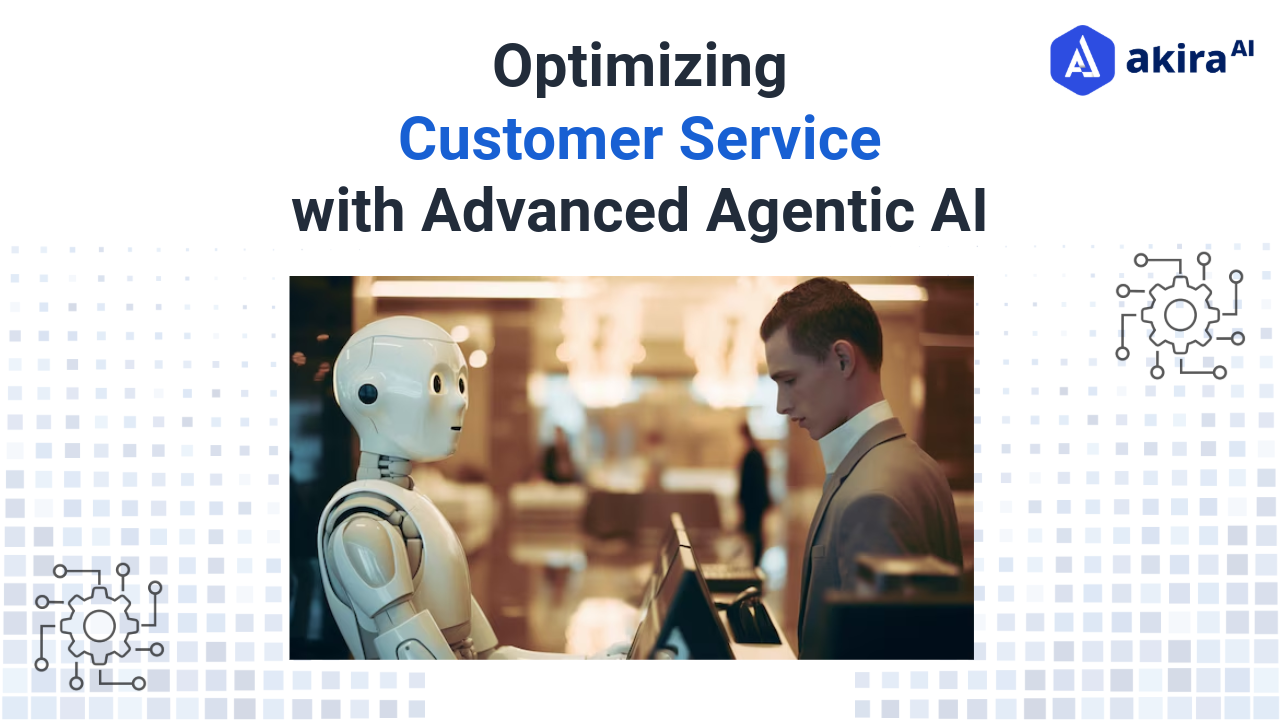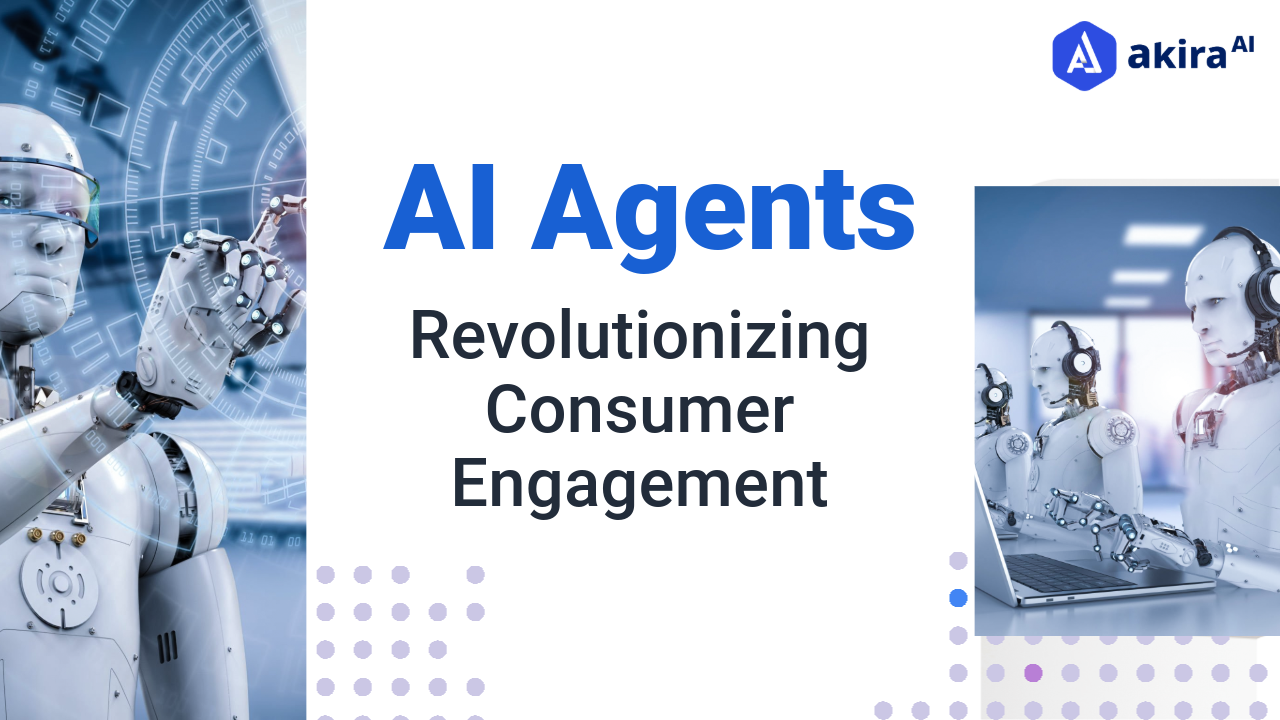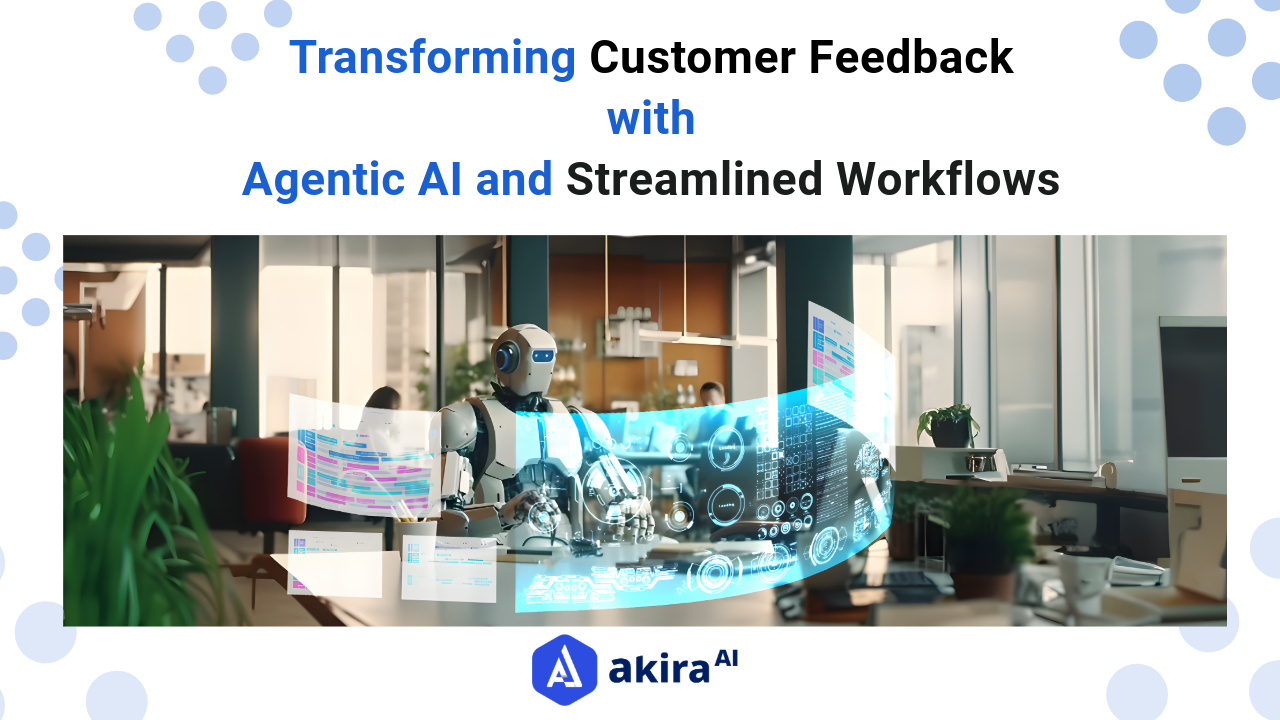In the modern, fast-moving business environment, customer feedback management is starting to be one of the key competitive differentiators for organizations that want to outcompete their rivals. Traditional mechanisms for feedback are efficient up to a certain extent but mostly face efficiency and scalability problems. This is where AI-powered agents come in, to introduce an entirely redefined process.
This blog post highlights how the multi-agent framework in Akira AI's feedback system can revolutionize the handling of feedback and opens new opportunities for organizations.
From Data to Insights: Customer Feedback Processing via AI Agents
AI Agents
AI agents are computer programs developed to perform their tasks by making self-guided decisions based on observations of their environment, input, and specific objectives. Unlike stiff automation systems, an AI agent thinks, adapts, and acts independently. They are designed to perceive their environment, learn from past experiences, and hence make decisions to attain certain objectives.
In fact, everything from the execution of simple single-task programs to complex multi-process system execution is an AI agent. Particularly, they are good in dynamic and unpredictable environments; they can access the Internet, interact with applications, process large volumes of data, conduct transactions, and continually improve their methods based on feedback.
AI Agents in Customer Feedback
The automation done by the AI agents allows collaboration at every step of automation and streamlining, right from collecting feedback data to realization into actionable insights. These two work in cohesion with data collected from different channels and then access customer sentiment by means of natural language processing, classifying it according to issues experienced with the products or services. AI agents are expected to drive real-time aggregations and analysis of feedback onboarding and offer precise recommendations for improvement.
Navigating Challenges of Customer Feedback
Dealing with customer feedback can be quite challenging, particularly as the amount of data increases.
- Unstructured Data: Much of the feedback received is in an unstructured format, such as open-ended survey responses or social media comments. Analyzing unstructured data requires advanced tools and can be resource-intensive.
- Sentiment Misinterpretation: Most of the customer feedback comes in an implied or indirect form of complaints; this cannot be determined by a traditional system. Misinterpretation might lead to misjudging the sentiment of the customer.
- Response Time: Customers expect quick resolutions to their issues, but traditional systems may take too long to process and act upon feedback, leading to dissatisfaction.
- Actionable Insights Gap: After collecting and analyzing feedback, organizations usually find it hard to gain actionable insights due to the vast amount of data. There is often a gap between issue identification and solution implementation.
- Feedback Redundancy: Organizations frequently receive duplicate or recurring feedback, which can lead to inefficiencies in analysis and overwhelm systems with repeated data that offers little new insight.
How AI Agents Address These Challenges
AI-powered agents address both major issues of customer feedback management-streamlining and integrating the feedback process in a very efficient way. They integrate most sources of feedback with one platform, which reduces data fragmentation, and through automated analysis, they interpret customers' emotions and sentiments enable organizations to respond promptly to critical feedback. AI agents bring much better coordination across disparate system components and integrate workflows. They ensure compliance and improve data security, keeping customers' data safe and in line with regulations. This means taking an end-to-end approach will let organizations fully use customer feedback while ensuring efficiency and security stand intact.
Akira AI’s Multi-Agent Solution
Akira AI's solution is a comprehensive system that automates the entire customer feedback process. Providing agents with round-the-clock processing gives them a real-time view of customer sentiment, categorizing feedback into actionable insights and recommendations for enhancement.
 Figure 1: Technical Architecture of Multi-agent System For Customer Feedback
Figure 1: Technical Architecture of Multi-agent System For Customer Feedback
Process Flow:
-
Data Collection: Feedback sources include a variety of information such as customer satisfaction surveys, social media comments, post-purchase surveys, website feedback forms, in-app feedback, and email/support tickets.
-
Data cleaning: The extracted data further undergoes aggregation and standardization processes. It is responsible for cleaning and organizing the dataset.
-
Sentiment Analysis: Then, the feedback is processed to classify both by sentiment and neutrality to measure the emotional tone and general perception towards the collected customer feedback.
-
Categorization: The feedback is categorized into specific areas, including product issues, delivery feedback, and service complaints. Targeted responses and key areas that need attention are identified.
-
Insight Generation: It brings out actionable insights from the sorted and analyzed data, highlighting trends, recurring issues, and opportunities for improvement, and also gives the big picture of customer feedback.
-
Recommendation Creation: After insights, recommendations will be generated in an effort to improve customer satisfaction.
-
Final Output: After all the agents have finished the processing, a detailed report is generated that includes sentiment analysis, categorized feedback, and actionable recommendations. The report aims to improve customer satisfaction and feedback processes through data-driven insights and suggested improvements.
Tech Stack Used In Autonomous Customer Feedback
The system's architecture incorporates the following technologies:
|
Layer |
Component |
Stack |
|
Multi-Agent Layer |
Agents |
LangChain, Langraph, Autogen: Advanced frameworks for developing, managing, and orchestrating AI agents. |
|
RAG (Retrieval-Augmented Generation) |
Langchain, Llama Index: To build efficient RAG pipelines, combining retrieval and generative capabilities. |
|
|
LLM (Large Language Models) |
Domain-specific LLMs: Specialized models fine-tuned for processing customer feedback and sentiment analysis. |
|
|
Feedback Processing |
Sentiment Analysis |
NLP models (spaCy, Hugging Face Transformers) for sentiment analysis; |
|
Feedback Categorization |
Categorization frameworks like Scikit-learn, TensorFlow for machine learning categorization of feedback issues. |
|
|
Integration Layer |
Data Ingestion |
APIs for integration with customer interaction tools (e.g., Twilio, Slack, Google APIs, Zendesk) to collect feedback data. |
|
Knowledge Base |
Elasticsearch or Neo4j: Provides a centralized knowledge graph for feedback orchestration and decision support. |
|
|
Backend Layer |
Backend Pipelines |
FastAPI, Flask, Django: For developing scalable and secure APIs that facilitate agent communication and feedback workflows. |
|
Frontend Layer |
User Interface |
React, Vue.js, Angular: For creating intuitive user interfaces that allow teams to visualize customer feedback data. |
|
Infrastructure Layer |
Infrastructure |
AWS, GCP,Hybrid cloud infrastructure |
|
Authentication & Authorization |
OAuth 2.0, JWT: Ensures secure user authentication |
|
|
Monitoring & Logging |
Prometheus, Grafana: For real-time monitoring |
Multi-Agent Component Overview
Our multiagent solution comprises various domain-specialized agents that work together to achieve a particular goal.
1.Master Orchestrator Agent
The central command unit directs the overall automation of the feedback process. It then accords with agentic workflow by delegating the tasks to other agents so that at every stage in the process, each step is free of errors.
It relies on an LLM for higher-order decision-making. The knowledge graph captures the routes, rules, and relationships related to this domain and integrates the results into the Master Orchestrator Agent. This agent ensures that all the subprocesses are executed in a fashion that is compliant with regulations.
2.Feedback Collection Agent
The agent aggregates feedback on customers from multiple touchpoints into a single system. Below is the list of several touchpoints involved in providing this feedback:
• Social media comments
• Post-purchase surveys
• Emails and support tickets
• Website feedback forms
The agent ensures that the feedback is gathered uniformly without any loss of insight or fragmentation.
-
3.Sentiment Analysis Agent
-
The agent annotates and interprets the customer's feedback by applying advanced NLP methods. Its major job is in the sentiment of customer comments, reviews, or submission of feedback. It evaluates feedback using three main categories of sentiment -positive, negative, neutral. Sentiment categorization of the feedback by the agent truly allows prioritization of critical responses and hence quick addressing of negative feedback.
-
4.Feedback Categorization Agent:
-
This agent allows for customer feedback to be segmented into its relevant categories, hence allowing the easy and quick sorting of big data and organization properly into relative categorizations. The appropriate mix of machine learning and classification models in the identification process categorizes feedback on some common issues
-
5.Complete processing:
-
Possibly the most influential component in the feedback loop, the last one is the Actionable Insights Agent. It processes analyzed unstructured and structured feedback for insights which might lead to actionable undertakings on behalf of a business. It provides a sentiment summary and category breakdown of the feedback and generates recommendations for improving customer satisfaction. The recommendations can include:
-
a) Product improvement
-
b) Service Upgrades
-
c) Operational changes
-
Traditional AI Solutions vs Akira AI Multi-Agent Solutions
Aspect
Traditional Solutions
Akira AI Multi-Agent Solution
Customer Satisfaction Surveys
Analyzes survey responses with fixed sentiment analysis models, often missing context-specific insights.
Applies generative models to open-ended responses from customer surveys, surfacing deeper insights and more detailed customer sentiment.
Product Reviews Analysis
It processes product reviews through a keyword-based sentiment analysis that misses subtle opinions.
Harnessing context-aware analysis, it helps understand those nuanced parts of reviews that betray specific strengths and weaknesses of products.
Social Media Feedback
It relies on predefined keywords and sentiment scores that might miss emerging trends and context.
Real-time insight on recent customer issues resulting from radically changing social media and trends.
Customer Support Interactions
Uses rule-based systems to analyze support tickets or chat logs suffers from bad performance regarding complex queries.
Analyze customer support interactions with generative models to understand customer problems better and improve the quality of responses.
Feature Requests and Suggestions
The static tags may not help categorize innovative or unexpected ideas, as well.
Categorizes and dynamically prioritizes feature requests to create an understanding of trends and new ideas from varied feedback.
Brand Sentiment Tracking
It monitors brand sentiment using historical data and fixed sentiment models—most likely without consideration for changes in recent times.
Continuously develops and updates the sentiment analysis based on the brand concerning any new developments and customer feedback.
-
Key Benefits of Autonomous Customer Feedback
Akira AI’s multi-agent system offers significant advantages that transform the way organizations handle customer feedback:
-
1.Enhanced Efficiency: Since the system automates the whole lifecycle of feedback-from collection to actionable insights-it reduces manual effort by as much as 70%, freeing teams to reallocate precious time and resources to higher-value strategic initiatives.
-
2.Unmatched Accuracy: The NLP technology used in Sentiment Analysis Agents can reach as high as 90% accuracy for sentiment detection, this will enable businesses to gain deep and reliable insight into the emotional tone behind customer feedback.
-
3.Effortless Scalability: The architecture that supports Akira AI is based on multi-agent architecture and provides continuous scalability assurance. This means that the performance and speed will even meet large volumes of feedback, which is continuously growing in volume.
-
4.Boosted Customer Satisfaction: With faster, more accurate insights, companies can respond to issues more quickly and effectively, resulting in a 30% increase in customer satisfaction. The system’s real-time feedback management helps improve the overall customer experience.
Conclusion: Agentic AI for Customer Feedback
Akira AI’s multi-agent solution is truly changing how businesses handle customer feedback. Automating collecting feedback to analyzing and categorizing it takes the pressure off organizations and solves some of the biggest challenges they face. The multi-agents collaborate to deliver accurate insight, which helps businesses stay agile and continuously improve, making it easier to keep customers happy and drive lasting success.
-
-


